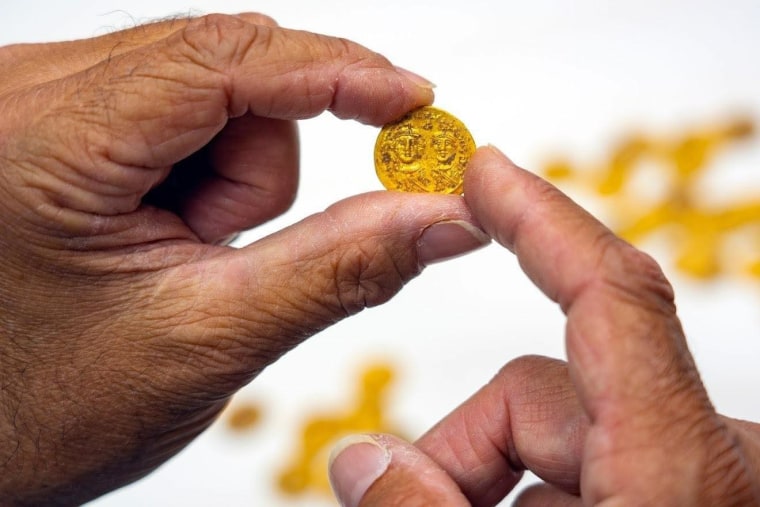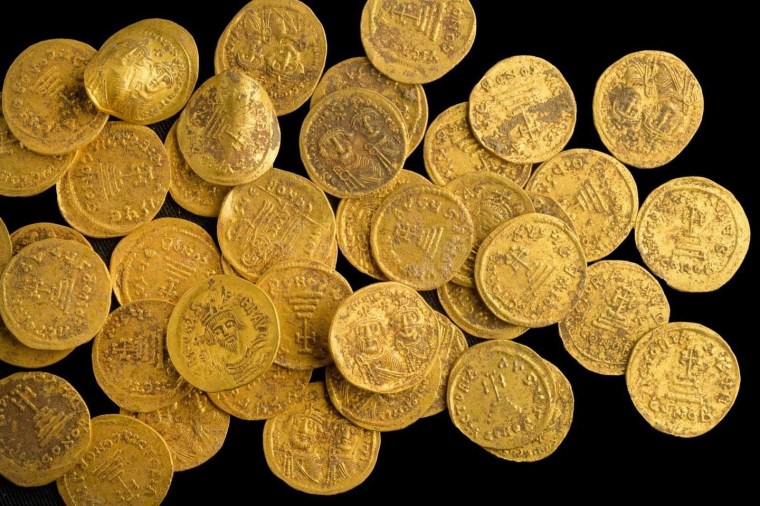When someone stashed 44 gold coins into a wall in the seventh century, they may have hoped to one day return and find their treasure again. Instead, almost 1,400 years on, the coins have been found by Israeli archaeologists, who hailed the discovery as a rare glimpse into an ancient past at a tense time of violent conquest.
The Israeli Antiquities Authority said Monday that it found the hoard at Banias, once known as Panaeas, an important spiritual site to successive cultures through history.
The pure gold coins, weighing about 170 grams (6 ounces), feature the effigies of emperors Phocas (602-610 A.D.) and Heraclius (610-644 A.D.), leading experts to believe they were hidden during the Muslim conquest of the area in around 635.
"The discovery reflects a specific moment in time, when we can imagine the owner concealing his fortune in the threat of war, hoping to return one day to retrieve his property," Yoav Lerer, the director of the excavation, said in a statement.
"In retrospect, we know that he was less fortunate."
The coins also reveal new details about the economy of the last 40 years of Byzantine rule in the area.
The Byzantine Empire, centered in what is now Istanbul, was a continuation of the Roman Empire after its collapse in the West following the sack of Rome by barbarian tribes in 410 A.D. The eastern empire would last another 1,000 years, but it lost several of its provinces to Muslim conquests of the seventh century — around the time the coins were stashed in the wall.
“Most of the coins are of the Byzantine Emperor Heraclius,” Gabriela Bijovsky, an expert on ancient coins who examined the hoard, said in a news release.
"What is particularly interesting is that in his early years as emperor, only his portrait was depicted on the coin, whereas after a short time, the images of his sons also appear,” Bijovsky said.
"One can actually follow his sons growing up — from childhood until their image appears the same size as their father, who is depicted with a long beard."
Remnants of pottery kilns, buildings, water channels and other coins were also found.
Now in a national park, Banias has played an important spiritual role in several cultures. First a Canaanite shrine to the god Baal, it was renamed in the Hellenistic era after Pan, the half-man, half-goat god of shepherds and fertility.
The site grew to its peak in the early Roman era under Herod and his son Philip II, who renamed it Caesarea in honor of the Roman Emperor Caesar Augustus.
In Christian tradition it is where St. Peter declared Jesus to be the son of God before he received the keys to the kingdom of heaven.
Banias is in the area known as the Golan Heights, which Israel captured from Syria in the Six-Day War of 1967 and annexed later, promoting settlements and a thriving tourism industry. Former President Donald Trump recognized Israel's sovereignty over the area in 2019, prompting strong protests from Damascus, but the rest of the international community regards the territory as Israeli-occupied.

The Banias excavation was funded by the Israel Electric Corp., which is working to connect the nearby Druze holy site of Nabi Khadr to the national electricity grid.
The discovery is being hailed as important as the uncovering this year of a church that archaeologists claimed was the birthplace of St. Peter.
"The gold coin hoard is on a par with the Byzantine Church, possibly the Church of Saint Peter, that was recently discovered," Raya Shurky, director of the National Parks Authority, said in a news release.
"The finds include the remains of a mosaic floor and a stone engraved with many crosses, indicating that Banias became a Christian pilgrim site."

